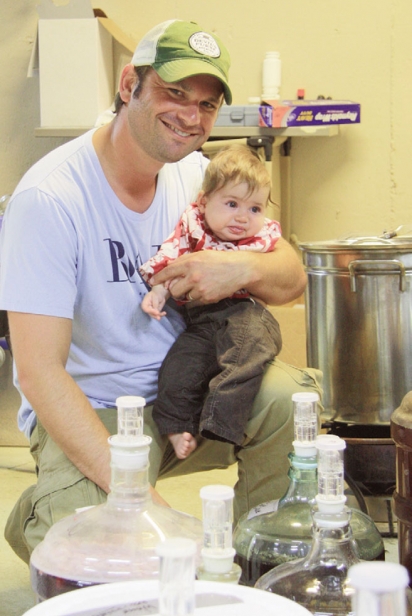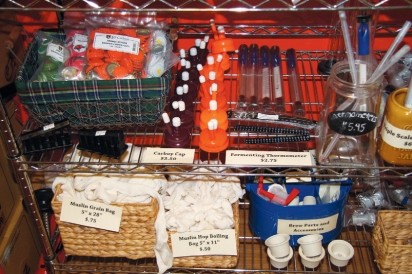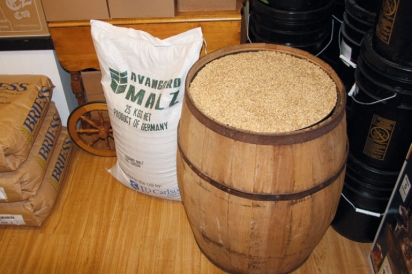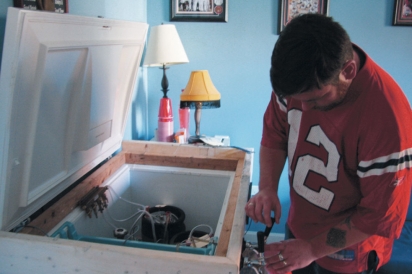A Tasty Bit of Homework
This cannot end well.
Watching the yeast drift down within a jar of water like a snow globe, I can’t help but wonder which of the many steps that I fouled up will be the undoing of my first entry into the world of home brewing. It’s a world long in existence, dating back thousands of years, and it’s now enjoying a resurgence in popularity as the realm of craft beers continues to explode.
As old as civilization itself, the earliest written evidence of beer dates back to ancient Egypt and Mesopotamia in the early fifth millennium B.C. Despite occasional governmental interference, or the odd temperance movement, beer is enjoyed the world over. More than 51 billion gallons will be brewed commercially this year, with China, the United States and Brazil leading the way in production. This figure doesn’t include the ranks of home brewers, which is sizable and growing. It’s estimated that there are 1.2 million home brewers in the United States alone.
Which brings us back to my attempt at joining their ranks. The first step is to collect the necessary equipment for the project: boil pot (20 quarts), fermenter (7-gallon bucket), bottling bucket (7-gallon with a spigot at the bottom), bottle capper, bottle caps, plenty of sanitizer, tubing to help with the transfer of the beer, and the actual ingredients that will make up the very first brew of the Egan Brewing Co. You will notice that bottles were not on the shopping list. I decided to collect them another way: buy pre-filled bottles and drain them slowly at home, usually with a football game on TV at the time.
There are two options to go to for home brew supplies on Cape Cod: Cape Cod Beer in Hyannis and New Farm on Route 6A in Orleans. Both locations have everything a budding brewer could need to get started, complete with recipes and ingredients in ready-to-go kits.
Home brewing can be a solitary endeavor right up until that last step when over two cases of newly crafted beer is ready to enjoy. That’s when the friends show up to help you with the process (where they were during the “bottle washing” step is a mystery). More reliable assistance can be found within the home brewing community from fellow brewers who get together at monthly brew club meetings across the country. On Cape Cod, there are two such clubs. C.C.L.A.M.S. (Cape Cod Lager and Ale Makers) meets the first Wednesday of every month at Cape Cod Beer, and the Brew Farm Club meets monthly at New Farm. Here brewers of all levels come together to talk, not just about beer, but also about mead, cider or wine. You can see where a novice might be a bit intimidated thinking these clubs cater to only the well-seasoned veteran brewer, but as Brew Farm’s Dave Miller explains, that’s just not the case, “We get first timers and guys who’ve been brewing for years.”
Miller, one of the lead organizers of Brew Farm, has been passionate about beer since a fateful trip to a local pub in Colorado some years ago. “I ordered a Rolling Rock and I was offered a Pliny The Elder,” Miller remembers. Pliny The Elder is an American double IPA from the Russian River Brewing Company in California, and it opened Miller’s eyes to what lies beyond the narrow scope of “fizzy yellow beer”. What followed was an exploration into craft beer that resulted in Dave brewing his own beer, and lots of it.
“I’ve brewed 75 batches and never the same beer twice,” he claims. Tweaking formulas is part of the fun in creating new flavors of familiar styles of beer. Adding different amounts of citrus fruit like lemons or grapefruits, and for varying amounts of time, can wildly change the flavor profile of a beer. Currently, Miller is fermenting, among others, a smoky chipotle porter, a dark English strong ale aged on black cherries and a double barrel Belgian Tripel aged on wine grapes. For the Tripel, Miller purchased a recycled bourbon barrel, fermented a batch of Cabernet Sauvignon in it for about seven weeks, and then placed the pale, robust (up to 9% alcohol by volume) beer inside. That’s a long way from, “Eh, gimme a Bud.”
Dave now calls Cape Cod home, along with his wife Kerry and their young daughter Marcelle. He was looking to bolster the home-brew community with a brew club, and Casey Zawicki and Lindsey Cook of New Farm stepped in to help. “The subject of home-brewing came up, and they said they’d love to do it,” Dave recalls. “I helped them get their inventories set up,” he adds. Miller went on to do more than that in establishing the Brew Farm Club. Eight people attended the first meeting two years ago, and now there are over 125 members receiving the monthly newsletter.
“It’s not about drinking. It’s about tasting,” Miller is quick to point out. “We’re not beer snobs. We’re about discovering new flavors.” To that end, the club’s members strive to help one another produce the best beer they can without competition within the group. A typical meeting breaks down into three segments. The first hour is focused on education. The topic of a recent meeting was “Head Retention”, referring to the familiar foamy cap on a glass of beer. Too much, too thin, doesn’t sustain well—it’s no small feat to get it just right. The second hour is dedicated to critiquing fellow members’ beers, when constructive criticism is offered to those looking for some guidance with their particular brews. The third segment is a social hour for further discussion of all things beer. While they’re not high on competition, the group will throw out an occasional challenge to its associates. Recently they were given a list of ten local ingredients for which to forage, and were challenged to include three of them in a beer.
Back in the laboratory, it’s brew day, and I’m trying to manage with the most basic ingredients of my inaugural brew: water, barley, hops and yeast. It’s a good idea, as a beginner, to brew a beer according to an established recipe (one that you like). In my case, I chose the Cape Cod Blonde. The Blonde is a golden ale that’s smooth and light-bodied. Cape Cod Beer has kits pre-packaged with all the ingredients in exact amounts and step-by-step instructions that make the brewing process almost foolproof. Almost.
As the water in the brew pot heats up on the side burner of the outdoor grill, I fill a muslin bag with all the crushed grains that will steep in the brew pot. Funny thing about those little muslin bags: they’re very stretchy. As the grains go in, the opening of the bag stretches until the grains begin to pour over the low hanging side and into the sink. Following the time-honored “Five-Second Rule”, I quickly scooped up a handful of spilled grains and tossed them back into the bag, knotted it up and threw it into the brew pot. Only then did I start to wonder about what other possible flavors might have hitched a ride with the grains.
After stirring in the liquid and dry malts, the recipe states (exactly): “BEWARE OF THE BOILOVER!” When the mixture first begins to boil, there is a chance that it could produce a heavy foam, so you need to keep your eye on it. My eye was more drawn to the cascading wall of water flowing down the sides of the pot, across the grill and onto the deck. I had a boilover on my hands! Quickly turning off the burner did the trick in calming things down within the pot…much like it did minutes later when a second surge vaulted from the vessel. (Later, I couldn’t help but wonder just how much potential beer I was hosing off the deck and scraping off the grill.)
After bittering and aroma hops were added, the boil was finished. Time to cool it down, add it to the three gallons of water already in the fermenter and pour in the yeast to begin the fermentation process. Only after the fermenter is all sealed up do the doubts creep in. Was the yeast OK? Was it alive? What about all the hops that remained stuck to the side of the pot? Should I have scraped them into the fermenter along with the beer? I suppose we’ll find out in two weeks, during the bottling phase.
People who really enjoy home brewing tend to be DIY types who like to cook and like science. People like Dave Miller, or Cliff Weiden of Mashpee. Weiden has been seriously brewing at home for just over a year, and he has already progressed to the advanced stage of kegging his beer. “Bottling got old real quick,” Weiden says. “Plus, there’s nothing like pouring yourself a pint of your own beer from the tap at home,” he adds. Weiden uses old Pepsi and Coke syrup kegs that hold five gallons. They are just the right size for a batch of beer.
When someone arrives at Cape Cod Beer looking to begin home brewing, owner Todd Marcus always asks whether he or she likes to cook or to bake. Because brewing beer, or mead, cider or wine, requires exact measurements, bakers tend to make better brewers because they adhere to recipes far more than cooks who may follow the “pinch of this/dash of that” technique. Another important point Marcus makes: “You need to take very detailed notes. How else are you going to improve upon what you’ve made? Was it too hoppy, too dark or too light?” Notes also benefit the brewer in chronicling the mistakes as well as the successes. If you make a mistake (like spilling grains in the sink) and the beer turns out great, you’d want to be able to recreate that misstep.
Marcus is happy to host the C.C.L.A.M.S. monthly meetings at Cape Cod Beer. “We’re here because of it,” he states. The club was instrumental in the early expansions of Cape Cod Beer, providing much needed assistance, help in the form of strong arms and backs, as well as moral support. As Todd explains, “It’s about the preservation of the hobby.” It’s a hobby that is in existence thanks to President Jimmy Carter.
On January 19, 1919, Prohibition began with the ratification of the 18th amendment. It banned the manufacture, sale and transportation of alcohol including beer that was made at home. The 21st amendment repealed prohibition in 1933, but, curiously, the legislation accidently omitted legalizing home brewed beer. It wasn’t until 1978, when President Carter signed into law an amendment that exempted beer brewed at home from taxation, that home brewing became legal. Now, the groundswell of craft beers and microbrews flooding the market today can be directly linked to the home-brew hobby.
It’s estimated that 90 percent of professional brewers began their careers as home brewers. Nationally, Sierra Nevada Pale Ale is widely considered to be the beer that shifted the American beer consumer’s perception of the beverage. Sierra Nevada was started in 1979 by Ken Grossman and Paul Camusi, two homebrew aficionados. Cape Cod Beer began in much the same way, and now the company’s 20 year-round and seasonal brews are enjoyed in well over 400 bars, restaurants and liquor stores across Cape Cod and beyond. The owners of Devil’s Purse, the new brewery on the Cape, were toiling away at home early on as well. Matt Belson and Mike Segerson had been members of Brew Farm before “turning pro”.
In 1995, there were 500 craft breweries in the United States. By 2001, that number had grown to 1458, producing 6.2 million barrels of beer. Today there are over 4000 such breweries, with another estimated 4000 in the works, including the growing roster of nanobreweries. They fall in the niche between the microbrewery and the home brewer. Some nanobreweries will produce a mere two or three barrels a year (62-93 gallons).
Back at the fledgling Egan Brewing Co.’s world headquarters, bottling day has arrived, and with it, my first chance to see just what I have concocted. I pry open the fermenter’s lid to reveal the same dark brown liquid that went into it two weeks prior. I give it the sniff test, and…it smells like beer. A good first step. I remove a sample to check the specific gravity of the beer with a hydrometer. It lets me know what the alcohol content is in the brew. Once completed, the beer sample cannot be poured back into the fermenter since it came in contact with non-sterilized equipment. Therefore, a taste test is in order. I take a sip…and another. I do believe I have beer! Flat, cloudy, room-temperature beer, but beer nonetheless! This beer, as with the vast majority of home brews, will be “bottle conditioned”. This means that a bit of dissolved priming sugar is added to the beer and when it is capped, the yeast will carbonate each bottle.
The whole bottling process is fairly straightforward and quick. Everything was going smoothly, until the spring-loaded bottle filler sprung its spring. Beer was overflowing the bottle and onto the kitchen floor before I realized what had happened. The smell of a brewery is probably not the aroma my wife was looking for first thing on a Sunday morning, and she did her best to concentrate on the pot of fresh brewed coffee on the counter (next to the four gallons of fresh brewed beer). All in all, I bottled 38 beers. The rest I’ll chalk up to a sacrifice made to the beer gods in the form of multiple boilovers during the brew day fiasco.
The practice of home brewing is enjoyed by over a million people in the United States, and it’s easy to see why. It’s a hands-on, creative process with (hopefully) a tasty result at the end. You’re only limited by your own imagination when it comes to developing new and exciting flavors. As with all hobbies, it’s not about the cost savings. The hobby aviator isn’t in it to save on airfare; it’s for the love of flying.
For home brewers, there are certainly thousands of choices of wonderful beer out there, but none will taste quite as nice as the lager of their labor. They all won’t be home runs, but that’s part of the challenge and the fun. No matter the outcome, the universally recognized response is to “Relax. Have a beer.” For me, the familiar “pfft” upon popping open a bottle, the tingle of carbonation on the tongue and the sweetness of the malt blended with the bitterness of the hops tells me all I need to know. I’ve entered the game of home brewing with a solid single. Next time I’ll try to stretch it to a double.












